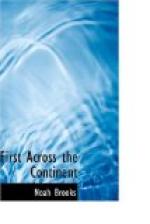To this day, all the Northwest Indians speak of anything that is highly useful or influential as “great medicine.”
One cold December day, a Mandan chief invited the explorers to join them in a grand buffalo hunt. The journal adds:—
“Captain Clark with fifteen men went out and found the Indians engaged in killing buffalo. The hunters, mounted on horseback and armed with bows and arrows, encircle the herd and gradually drive them into a plain or an open place fit for the movements of horse; they then ride in among them, and singling out a buffalo, a female being preferred, go as close as possible and wound her with arrows till they think they have given the mortal stroke; when they pursue another, till the quiver is exhausted. If, which rarely happens, the wounded buffalo attacks the hunter, he evades his blow by the agility of his horse, which is trained for the combat with great dexterity. When they have killed the requisite number they collect their game, and the squaws and attendants come up from the rear and skin and dress the animals. Captain Clark killed ten buffalo, of which five only were brought to the fort; the rest, which could not be conveyed home, being seized by the Indians, among whom the custom is that whenever a buffalo is found dead without an arrow or any particular mark, he is the property of the finder; so that often a hunter secures scarcely any of the game he kills, if the arrow happens to fall off.”
The weather now became excessively cold, the mercury often going thirty-two degrees below zero. Notwithstanding this, however, the Indians kept up their outdoor sports, one favorite game of which resembled billiards. But instead of a table, the players had an open flooring, about fifty yards long, and the balls were rings of stone, shot along the flooring by means of sticks like billiard-cues. The white men had their sports, and they forbade the Indians to visit them on Christmas Day, as this was one of their “great medicine days.” The American flag was hoisted on the fort and saluted with a volley of musketry. The men danced among themselves; their best provisions were brought out and “the day passed,” says the journal, “in great festivity.”




